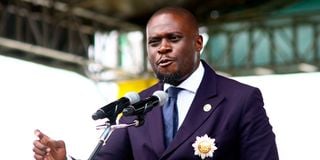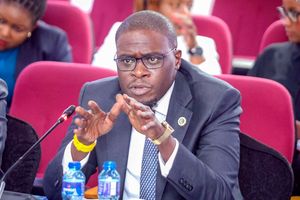
Nairobi Governor Johnson Sakaja
Johnson Sakaja, the Team University graduate we elected as our Nairobi governor says he is getting overwhelmed. (Hands up if you are not surprised).
There is a reason for that: Nairobi is a playground of interests. It is the capital of worship and sin, of shame, incompetence and fraud. For tender-preneurs, it lives to its original name, “Enkare Nyrobe” – the place of cool running waters.
When I saw Cabinet Secretary Kithure Kindiki hand to private interests, and through a gazette notice, the only land that had been reserved for Nairobi sewerage works, and the Governor did not protest, I knew that the city is now administered from elsewhere and that there is no vision.
Prof Kindiki, for he is a professor of law, knows that any land acquired through compulsory acquisition is not available to a third party. And that if a public entity has no interest in such land, it should revert to the original owner. That is the law – and therefore that re-grabbing of Ruai land is a zero-sum game.
Perhaps we may have to describe Nairobi in the words of colonial writer Elspeth Huxley when she called it a “frog-invested swamp”.
Nairobi was started by merchants, the initial dukawallahs who preceded the colonial administration. It looks like Sakaja came to town without a road-map.
When he started, I wrote a piece here reminding him the words of colonial maverick Ewart Grogan as he welcomed a new governor to Kenya who the settlers thought that he would make a difference. I always like paraphrasing Grogan for he said: Before we get down to do business with you Sir, before we tabulate all our innumerable woes of the last 14 years, we are entitled to know whether you have been sent here as another telephone exchange girl…
This country is not willing to be governed by secretariat officers, men of little more brains than the creatures that crawl around the bottom of the sea… we want people with vision that extends beyond the end of their noses.
Sakaja is not the first Nairobi leader to say that he is overwhelmed. There was a time we had the allhat-and-no-cattle Mayor, Steve ‘Magic’ Mwangi, who mesmerised us with his ‘Nairobi we Want’ blueprint, which was funded by the World Bank.
Mwangi had organised what was known as the Nairobi City Convention and many professionals and ordinary citizens, looking for a better Nairobi, gave their views. We all thought he had the sterner stuff that that leaders are made of.
We were wrong when he was scared out of the office by “Club 45” – a gang of Ford Asili councillors led by John King’ori. When he became the Mayor of Nairobi, King’ori didn’t seem to understand the task.
“What is your agenda for the City?” he was asked by a journalist. “I have no agenda,” he replied. The King’ori group not only trashed Mwangi’s vision, but Nairobi’s “hustler” community cheered his fall. He was dismissed as “snobbish” for he stood for the development of a middle.
As he told Parliament in 1995, after he was elected as Starehe MP, “The middle class is the one that guarantees the security of this nation because we have people who can work for eight hours a day without getting tired or wanting to have more. Let us develop that middle class and let us recognise and honour them. [For] that is the only way this country will move forward without the kind of chaos we have at the moment.”
As we learnt later, an “agenda” to King’ori meant a “sinister motive”. From his Accra Hotel and Lodge, King’ori would purport to run the city though the real power rested with the Town Clerk, Zipporah Wandera and her Planning counterpart, Kuria wa Gathoni.
But in the configuration, the Nairobi oligarchs drew their might from the State House. When I saw “Super Senator” Sakaja waving his manifesto during a TV talk-show with Jeff Koinange and swearing that cartels won’t frustrate him, I knew he was in for a big surprise.
In the first place, Sakaja had not campaigned for an orderly Nairobi. He was for “kila mtu aachwe afanye biashara yake”, which is the root of indiscipline.
If he is getting frustrated that “Hustlers” are pushing back as he tries to run a disciplined city, it is because of his double-speech. Having said that, Nairobi should return to the basics of the first administrator, John Ainsworth. When handed what chief railway engineer George Whitehouse described as a “desolate… windswept swamp”, Ainsworth was practical.
He brought the blue-gum trees we see all over Nairobi and envisioned having large boulevards for a future city. If you want to know that vision, look at the width of Kenyatta Avenue – or what was then Sixth Avenue. He started lighting the town and had a network of “nightsoil” operators collecting human waste.
Nairobi was initially running without a by-law, and the leaders had to adopt the Muthaiga Township by-law to administer the new town. That is how leaders borrow from the best, unless they are pretenders.
Once upon a time, Nairobi invested in the Kenya Bus Service, and the vision was that it would later have a subsidised transport system within the city. Had that worked, we would not have the menace of the Matatu and now bodaboda.
The mixture of Matatu and bodaboda indiscipline – and you can add the hawkers who have invaded the streets to that mix- is enough to raise Sakaja’s blood pressure. Yet, he has no solution because it is weaved with pre-2022 populism and 2027 paranoia.
His attempt to send some of the Mt Kenya Matatus to Uhuru Park’s Green Park was resisted by matatu owners and the politicians who look at the industry as their pot of votes. The great traveller John McCutcheon, a man who watched Nairobi’s pioneer days, described it in 1910: “Nairobi is not a beautiful place, but it is new and busy, and the people who live there are working wonders in changing a bad location into what someday will be a pretty place.” We have certainly not made Nairobi a “pretty place”. We have only been “busy” turning the city into a chaotic, unplanned mess.
Our leaders, starting with Charles Rubia, were at home purchasing symbols of power and privilege – and one of the legacies is that NCC 1, the classic Vanden Plas Princess, was bought after Nairobi protested the attempted purchase of a Rolls Royce.
The vehicle was used as the official vehicle by successive Nairobi mayors – and now governors as a symbol of power. But it is power within chaos. McCutcheon described the chaos in early Nairobi as a place where “Rickshaws, pedestrians, bullock carts, horsemen, and heavily burdened porters are passing constantly back and forth, almost always in the middle of the street”.
That is the disorder that Nairobi found itself in after pioneer administrator Ainsworth was transferred to Naivasha in 1906. Before Sakaja, we had elected the king of ‘bling-bling’ Mike Mbuvi Sonko to run the city. With Sonko, we learned that our leaders reflect the voters’ combined wisdom and illustrate the depth of their civic education.
Later, Sonko’s sea of supporters was nowhere to be found when he signed off on his powers to another entity championed by President Kenyatta. Having said that, Sakaja should take charge of the city. If he doesn’t, the interests that reside at State House and those that took over Ruai Sewerage land will control him like a Russian marionette.
Finally, as told by Controller of Budget Margaret Nyakang’o, he has to come up with a plan to pay the Sh107 billion (as of June 30, 2023) that the city owes suppliers. At worst, he can still throw in the towel – Sonko-style. So far, his vision is a mirage.










